AIR 16 Feature: Josué Morales Urbina
Ciara McNamara, Artist Programs intern at TAC, got together with current AIR 16 resident Josué Morales Urbina:
Ciara: Your work is primarily installation-based, what draws you to installation art?
Josué: It's because of the alchemy and serendipity that happens with installation art, it's a very malleable art form. There's a plasticity lending itself to size and specificity. It is also the experiential aesthetics that draw me to installation art. Also, the pleasure of installing and the way that installation art happens while installing is something I really enjoy. It's kind of like a drug… I first think about the material in conjunction with my childhood experiences and ideas. It becomes a conceptual project because you are walking around, immersed into a world of ideas and questions.
I think not only about visual art where it activates your sight, but also the other senses of smell, touch, sound and taste. There is something called visual texture where you can see the material and based on your visual experience, infer what that texture feels like because of your human-lived experience. My experience of the world has always been very sensory oriented which is why I tend to use material that has a lot of texture. Growing up, my granddad was an architect, and my environment felt very physical.
My granddad would take me to construction sites sometimes as a kid and I always liked to feel the materials around me. I cut my pinky finger on a sheet of metal I was touching and nearly lost it. I was very taken aback by the material.
When I was growing up with my mom, I always sensed how happy she was cooking, experimenting with her laboratory of ingredients. The backbone of my art making is the memories of my early childhood. Many of my installations have to do with those experiences and materials that I keep circling back to.
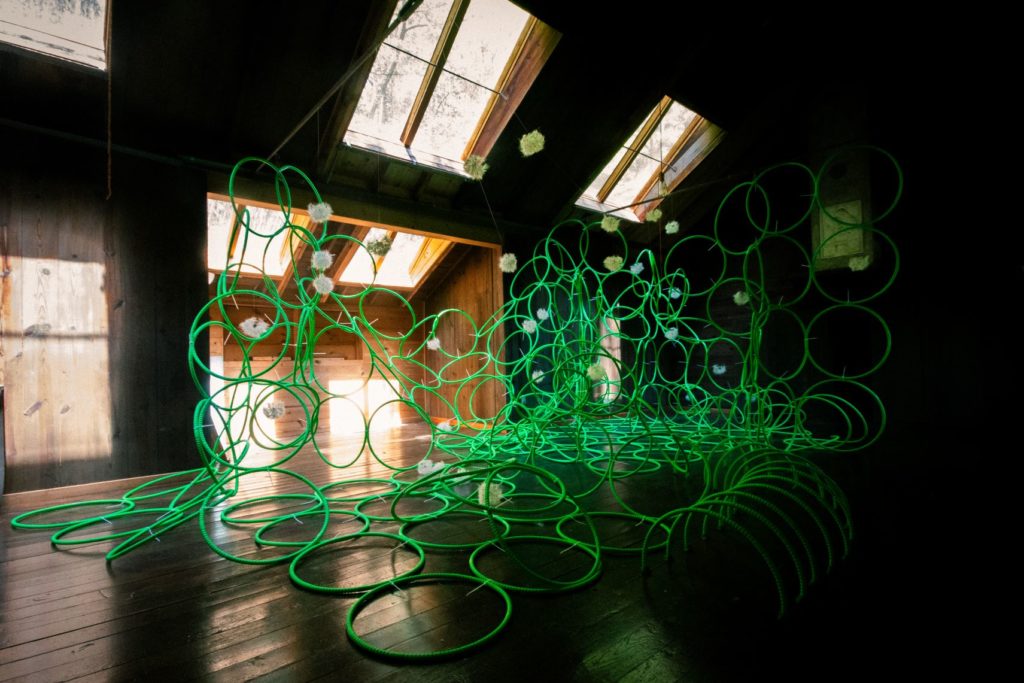
Ciara: Has your art always been centered around installation?
Josué: Before I discovered installation as an art form, I started with drawing. My work still has a lot to do with drawing because of its linearity. Textiles are also all lines moving in different directions. My definition of a line is energy in one direction. If lines go all around, then you have energy moving in all directions. When it comes to installation art, an obsessive desire naturally takes over.
Ciara: You frequently incorporate household objects as material into your artwork, how do you feel that these materials inform your artwork?
Josué: I think there is a lot of poetry that these materials bring. Ordinary household items are typically overlooked, but I choose to make them the protagonist. I am transforming the items into a large excessive installation, placing them at the forefront.
These materials are also representative of a culture or the experience of anybody in a minority. I’ve had discussions with minority artists that tend to do what I do, working on a large scale, because we want to see ourselves in that way. We want to be seen, placed at the forefront, and I think that in correlation these materials I choose want to do the same thing. They say, look at me! Look at me! I’m an orange, or a mandarin, or a coffee ground, or a rubber band. A drinking straw or a feather.
They want to be seen, but another reason we easily let them go by is due to the excessive nature that this country is operating by. When I first came to this country, the idea of excess caught me completely off guard. While my work is focused around excess, it’s more about looking at the other side of the coin. Looking at society and seeing how places like Amazon and big supermarkets have so much abundance of items that we don’t really know what to do.
Ciara: How do you choose which household items to incorporate into your installations?
Josué: The process can definitely vary. For the longest time I had a very deep relationship with the drinking straw. I remember as a child, I was very interested in not only the straw itself, but also its linear hollow shape. The physicality of the straw as a material being could mean many things. The poetics of a straw go far beyond the physical idea of space, line, or perhaps even color. Straws have a transparency, a translucency, and a transformational quality.
There's another piece that I made called Ikigai (2024), that played with scent, where I introduced the aroma of an unrecognizable fruit. It was an artificial, synthetic scent, and the whole piece was about plastic. The material I used was a bright green recycled-hula hoop piece. The piece is both all encompassing of artificiality while also engaging with a natural, garden-like state. Conceptually, the installation is about ambiguity, and viewers had many curious conversations regarding the ambiguous nature of the whole installation, especially the scent of an unrecognizable fruit.
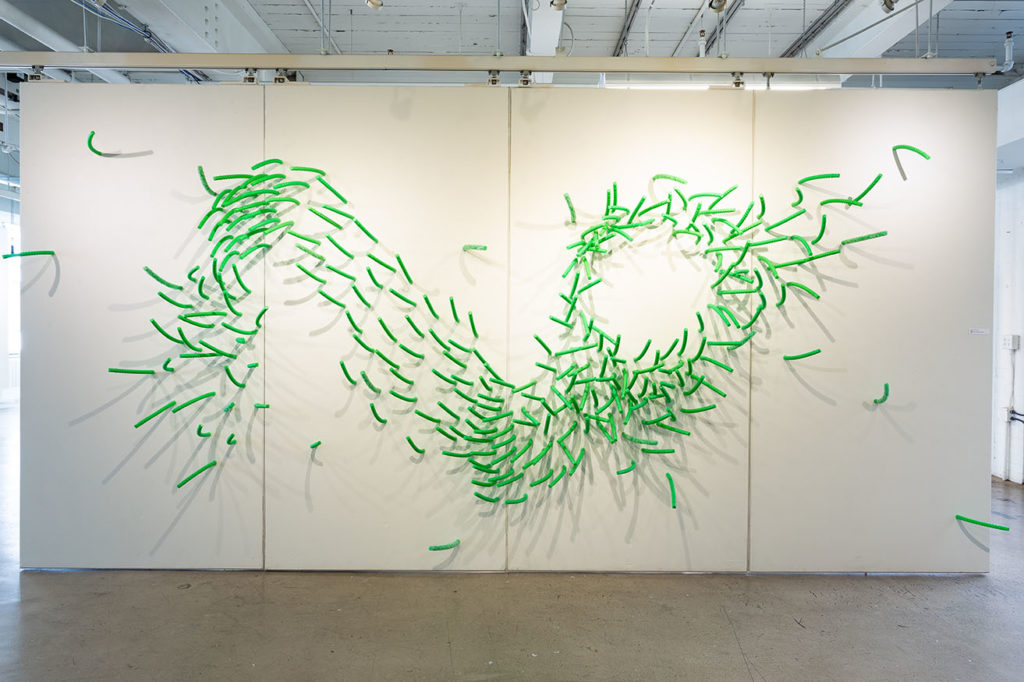
Ciara: So… What was the scent after all?
Josué: It’s unrecognizable. If you want to know the truth, the actual memory where it came from was this fruit called manzana rosa that I had during my childhood in Guatemala. It smells and tastes like a rose, but it is a fruit.
Ciara: I am very curious about your decision to use edible objects such as orange peels, white bread and honey in some of your installations. Can you speak further about why you choose these materials?
Josué: All of these materials are mundane, and mass produced. They have a tactileness that visually connects to their edibility. One of my installations, Meliflua (2023), uses the material of honey. The idea came about based on another childhood memory of mine. My granddad came home with a honeycomb bursting with honey which is when I learned where honey came from. I learned that the sticky, sweet, rich amber colored material came from bees. There is also the use of coffee beans in my work which has a lot to do with my cultural identity in Guatemala, which has an abundance of coffee.
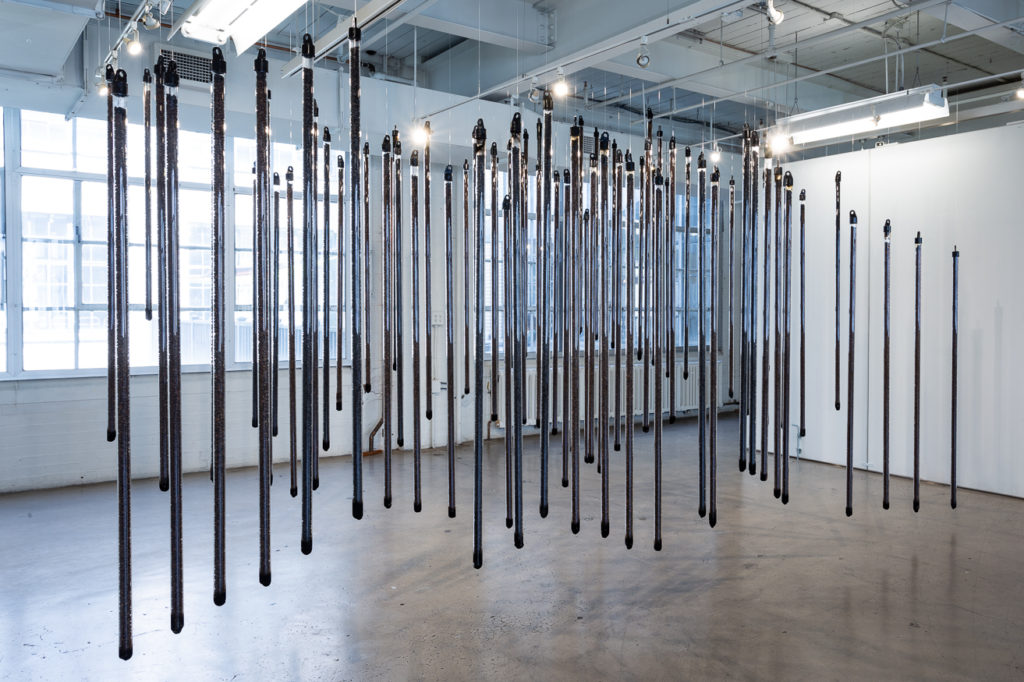
Ciara: I noticed the many mandarin peels and mesh construction wrapping you have pinned up in your studio, are you planning to explore those materials for your project?
Josué: Yes! I was given the bright orange mesh by an artist, a friend of mine, who didn’t need it anymore. They knew I was beginning to explore textiles further and thought it would be a great material to experiment with. I’ve also been restricting myself into making art with the constraints of not choosing the materials that I am using, but instead having the materials choose me. The melding of the mesh and the mandarin peels is a juxtaposition of the artificial and the naturally occurring.
Ciara: How has being born in Guatemala City and growing up across the United States shaped your art practice?
Josué: Being Guatemalan has everything to do with me because that's how I see myself. The nostalgic aspect in my art is interrelated with transcultural displacement; having to learn to adapt to different environments. It is one thing to visit a place, where it’s a whole other thing to actually live in a place. You adapt to the language and culture of that place and suddenly you become completely influenced by that new place.
Since my childhood was experienced in Guatemala, my ideas are based around going back through my memories and reclaiming what I have lost, and what I will never be able to retain again. The ephemeral, edible materials, the poetic qualities, exist in the world only for a very short period of time. Installation art lends itself to the constraints of a time frame. It has to cease to exist and to exist again, must be re-made.
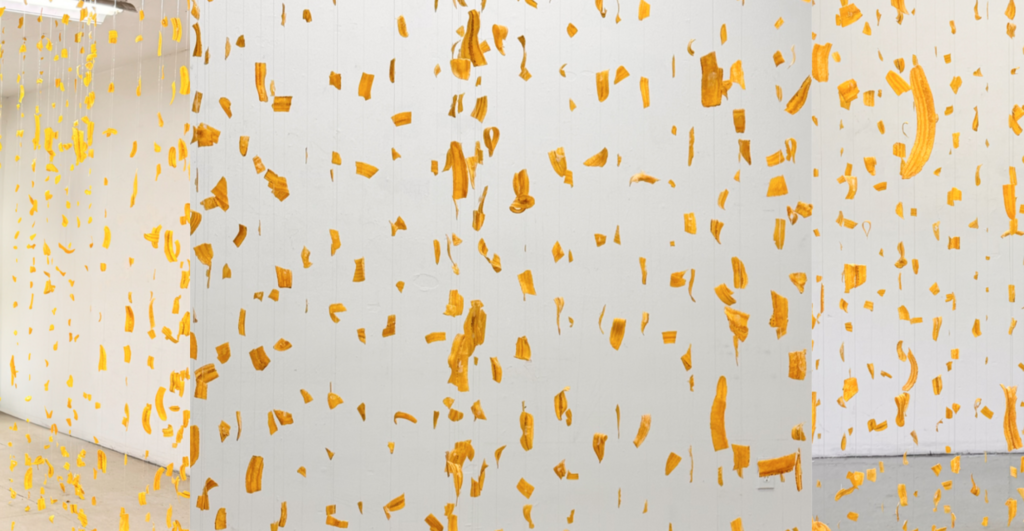
Ciara: I want to shift gears a little bit to the Textile Arts Center. What led you to becoming an artist in residence at the Textile Arts Center?
Josué: My roommate at the time was always talking about the Textile Arts Center. She did a residency at TAC in the past. I’d say she did a pretty good job radicalizing me into the community and culture here. I also have always been very interested in ideas around construction and how textiles have always been a valuable part of my identity. In Guatemala, there is a strong textile tradition where different ethnic groups identify one another by the textiles they wear. Visually, textiles have always been present for me but always in the peripheral. Coming to TAC, I really wanted to learn new ways of construction.
Ciara: Now that you're nearing the end of the second part of the TAC residency, where you research and propose a project for the final exhibition of the AIR 16 cohort in June, I’d love to hear about what you have been researching, and any ideas you are working through currently.
Josué: One idea that I have been working through is exploring the viewer as the material. There is a lot to play around with there. We all express ourselves aesthetically through textiles, whether it be or clothing or the textiles we place in our surroundings.
Ciara: Well I am very thrilled to see where all of that will take you! Thank you for chatting with me.
Join us for TAC's 16th AIR final show
TAC Artist-In-Residence 16 Final Exhibition: Salt Water Remembers
Opening Reception: September 11, 6:30pm-9:30pm
Guided Tour: September 20, 4:00 pm -6:00 pm
On view: 11-24 September 2025 at the Textile Arts Center, 505 Carroll Street, Brooklyn NY 11215
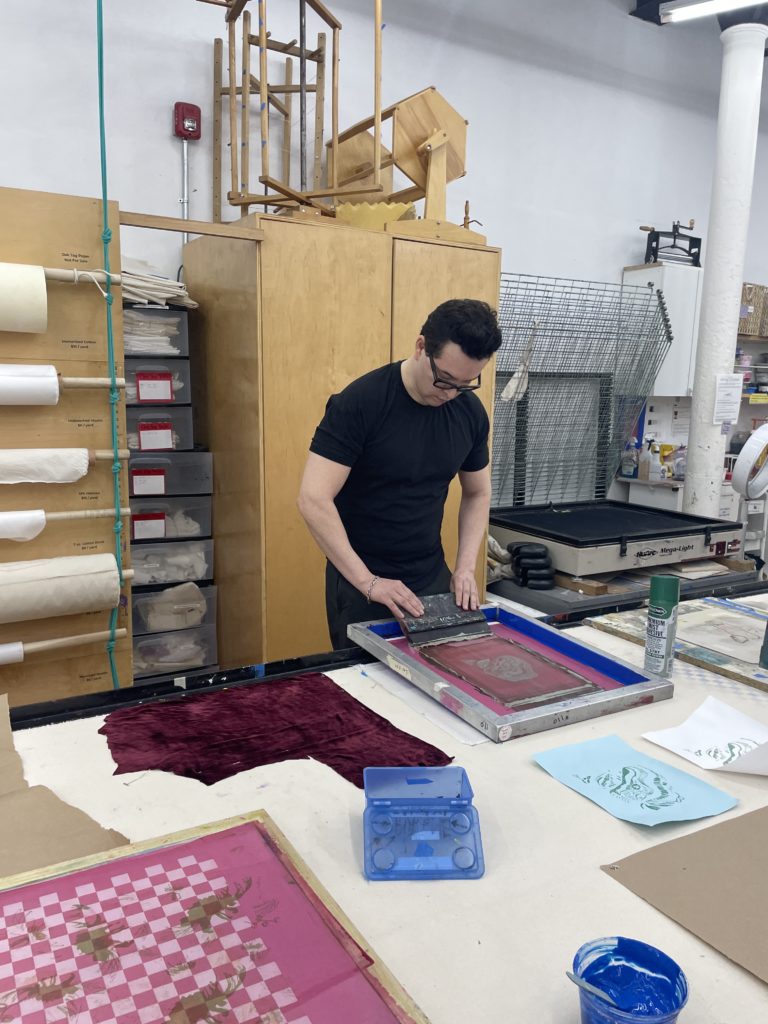
Based in the New York Metropolitan area, Josué Morales Urbina is an award-winning installation and sculpture artist, whose work primarily explores transcultural displacement. Among frequent themes that arise in his art are a pervading sense of foreignness and the impermanence of memory, which he examines via contemplative abstract installations. These works are composed of a broad range of materials, including ordinary household objects such as, drinking straws, coffee beans, toasted white bread, and rubber bands. The questions of foreignness in Morales Urbina’s work are rooted in his being born in Guatemala City, Guatemala, and having lived across the United States as a “third culture kid” (an individual raised in a culture other than their parents').
Yet, as much as he creates to engage audiences in such explorations, Urbina’s artmaking has also afforded him the self-discovery that he, ultimately, creates art “to build a home for myself; my art practice is my home.” Among Morales Urbina’s notable achievements as an artist are his solo and group exhibitions in New York, New Jersey, Pennsylvania, New Mexico, Oregon, and Texas. An alum of the Skowhegan School of Painting and Sculpture, he has completed artist residencies at the Vermont Studio Center, La Napoule Art Foundation’s Résidence d'Artiste Internationale, Centrum in Washington state, GoggleWorks, and Byrdcliffe Arts Colony. In 2023, he was recognized as a Sculpture Finalist by the New Jersey State Council on the Arts and was most recently awarded the 2024 Jersey City Arts Council Individual Artist Fellowship.
About the AIR program:
TAC AIR combines studio access with a rigorous interdisciplinary curriculum, and regular critical dialogue, providing residents an opportunity to learn and explore the textile medium, and an alternative to traditional higher education programs. The residency culminates in a group exhibition produced and hosted by TAC. Since 2010, TAC AIR has graduated over 100 artists and designers whose work continues to further textile art within the fashion, fine arts, design and art education fields.